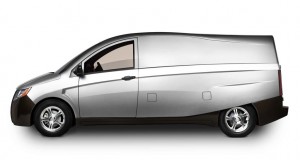
The Bright IDEA is designed to deliver 40 miles on battery, 36 mpg on gas -- and target a segment of nearly 1 million trucks annually.
General Motors’ new venture capital unit is investing $5 million to help a struggling Indiana start-up bring its high-mileage plug-in hybrid commercial vehicle to market.
Bright Automotive originally had hoped to launch sales of its IDEA truck by 2012 but got sidelined by the global economic crisis. Now, with GM’s cash – and technology – the start-up company believes it can put the project back on track by 2013 or 2014, targeting a lucrative fleet vehicle market that accounts for nearly 1 million sales annually in the U.S. – and even more abroad, Bright officials say.
“Our program has been put on hold for some time, but our partnership will reinvigorate the IDEA,” said Bright Automotive Chairman and CEO Reuben Munger, during a joint teleconference with John Lauckner, the president of newly-formed GM Ventures.
As originally envisioned, IDEA is a lightweight, highly aerodynamic plug-in hybrid that will yield nearly 40 miles on battery power alone and then get as much as 36 mile per gallon in gas-electric mode. The new partners said they have not resolved some specific technical details of the updated commercial vehicle but Bright is now likely to turn to GM to provide one of its inline-four-cylinder engines for the project.
Unlike the Chevrolet Volt, IDEA will be a parallel hybrid. That means the truck will be able to run on electric or gasoline power or a combination of both. The 2011 Volt is a series hybrid, which means that even when it switches to petrol power, the gas engine will serve only as a generator. Its electric motors always drive its wheels.
Also, IDEA will be what has been dubbed a through-the-road hybrid. The I-4 engine will power the front wheels, its electric motor will run the rear, essentially creating a hybrid all-wheel-drive system.
The truck will use a small lithium-ion battery pack – more compact than the one Ford plans to use in its upcoming Transit Connect Electric, even though IDEA will be a larger vehicle. But Ford’s battery truck will operate solely on electric power, with a range of no more than about 100 miles.
Munger noted that Bright has yet to sign up with a specific battery manufacturer, though the small start-up will work with GM to make the appropriate selection, he said. That could give a leg up to the Korean LG Chem, which is General Motors’ partner on Volt (and Ford’s on the upcoming Focus Electric). But there are numerous other options, including EnerDel, which is located in Indianapolis, not far from Bright headquarters.
Another unanswered question is whether IDEA – or some variant – will be marketed solely by Bright or also offered through one of General Motors’ distribution channels. That hasn’t been decided, “nor if it would fit in,” cautioned Lauckner.
But both Bright and GM executives agree there’s a potential significant market for a vehicle that could serve a variety of light to mid-duty applications, such as a cable company utility truck or a delivery van for vendors like Pepsi and Frito-Lay, both of which Bright has been talking with, Munger confirmed.
The Indiana firm has an ambitious production plan, looking at capacity that would reach about 50,000 trucks a year. That’s still a modest share of a segment that accounts for more than 900,000 sales annually in the U.S. And, stressed the Bright chairman, the market is even bigger in Europe – where such vehicles command an even higher price than in the States.
Lauckner said he believes GM’s investment – which will give it a “minority stake” — will serve as a “catalyst for other investors.” For his part, Munger said he is “hopeful and optimistic” that GM’s involvement will finally encourage the U.S. Department of Energy to approve Bright’s application for a Section 136 loan. Similar assistance, designed to encourage the development of high-mileage vehicles, has been approved for other electric vehicle makers, including Tesla Automotive and Fisker Motors. Ironically, both those companies will eventually build their products in former General Motors plants.
